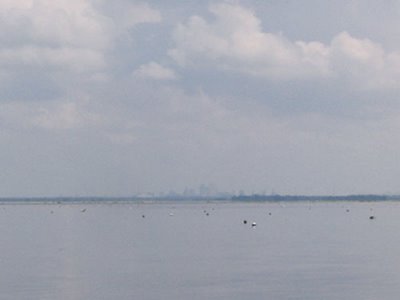A Year Without Progress
A year later and no real progress has been made in reducing the risk of flooding in New Orleans from future hurricanes. To recap, Hurricane Katrina was a moderate sized storm that passed to the east of New Orleans bringing the greatest wave and wind energies to bear on the Mississippi Gulf Coast. Flooding occurred to St. Bernard Parish, New Orleans East, and much of Orleans Parish west of the Industrial Canal from waves overtopping the levees, quickly followed by catastrophic failures of flood walls and levees (that were never overtopped) that severely flooded New Orleans making it impossible to remove the water via forced drainage. Since the storm, the only flood control measures implemented have been to repair the damaged levees and flood walls and start to bring the levee system back up to their original design levels (approximately Category 3 protection).
What this means for ALL metro New Orleans residents is that if a similar or larger hurricane passes just west of New Orleans, all of New Orleans will flood, even without any levee failures. Barataria Bay will rise over the levee system on the West Bank and flood the West Bank communities; Lake Pontchatrain will crest the Orleans Parish levees and flood Orleans and East Jefferson Parishes. St. Bernard Parish will be flooded from the south and east. This has been predicted by numerous modeling efforts and continues to place all of Metro New Orleans at risk.
Immediate steps that can be taken to reduce wave height from this type of storm include coastal restoration projects such as rebuilding the barrier islands with offshore sand sources and large-scale river diversions. The wave heights can be greatly reduced by forcing the waves to cross tall, wide barrier islands and then cross 50+ miles of intact marsh. Implementing coastal restoration projects is expensive but will have long-term self-sustaining benefits to hurricane and flood protection in Metro New Orleans. It also provides protection with a minimum impact to existing infrastructure. The cost tag is the problem and would probably require the state and Federal governments to pony up about $1 billion annually for approximately 10-15 years. However, that cost is minor compared to building massive flood control projects.
Category 5 hurricane protection by levee alteration is a great idea, but will take years and years (if ever) to implement. The size of these monster levees and flood walls, and other wave reducing components within the coastal marshes and bays will impact the aesthetics and infrastructure of New Orleans causing a tremendous amount of controversy. Because of this (and a cost that is probably tens of billions of dollars), I would be surprised if an infrastructure associated with Category 5 protection system gets built in the next 25 years.
Insurance companies, industries and future residents will all look at this problem before locating or rebuilding in New Orleans. Investment is the key to rebuilding and will only take place when progress is made on real flood protection, and the fastest, least controversial and likely least expensive way to do that is through coastal restoration projects. Therefore, New Orleans cannot truly rebuild until the risk of flooding from a moderate sized hurricane is minimized and this can only be done quickly by fully funding large-scale coastal restoration projects. Planning for many of these projects, such as barrier island restoration, has been underway for years and they only lack funding for immediate implementation. However, the Federal and state governments continue to underfund this quick and relatively easy solution to the risk from storm-induced flooding while starting new planning efforts towards hard-structure solutions for Category 5 protection.
UPDATE, 30 AUGUST 2006--5:48am:
TAGS: Katrina, New Orleans, NOLA, Coastal Restoration, Louisiana, Corps of Engineers


1 Comments:
So, I wake up this morning in a hotel room (like usual) with today's USA Today shoved under my door. Reading through the Katrina-related stories I come to an editorial by John M.Barry, who manages to steal my thunder. To read a well-written discussion of New Orleans' physical dilemma I recommend Mr. Barry's piece: http://www.usatoday.com/news/opinion/editorials/2006-08-29-katrina-forum_x.htm
Post a Comment
<< Home